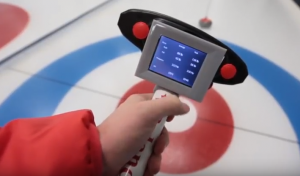Smart Broom Sweeps Curling
Curling is the Henny Youngman of Olympic sports – it gets little respect outside of the small circle of fans and players who revel in an icy version of shuffleboard… played with heavy “stones” that look like kettles and brooms that look like Swiffers.
But even this venerable game has been touched by technology. In this case, an engineered “SmartBroom” that has changed how athletes train and play. The New York Times (2/6/18) reports on its development by two Canadian engineers, Andrew Flemming and Geoff Fowler, who brainstormed over beer and tinkered in obscurity for months to come up with a high-tech training device. They soldered. They printed three-dimensional models in their basements.
The “SmartBroom” that emerged could help determine who takes home a medal at the 2018 Winter Olympics in Pyeongchang, South Korea. 
Matt Hamilton, a member of the United States men’s team who will join his sister, Becca, for a shot at gold in the inaugural Olympic mixed doubles curling competition, overhauled his sweeping technique after training with the sensor-studded SmartBroom. Curlers from eight of the 13 national curling federations sending teams to Pyeongchange, including from China, Denmark, and Switzerland, have used to to prepare for the Winter Games.
In essence, each SmartBroom provides instantaneous data on a sweeper’s force (in pounds), stroke rate (in hertz), and a metric called “sweeping performance index” that combines power and speed in one easy-to-absorb figure. Continue reading the New York Times story.
How crucial is sweeping to strategy and success? “The sweeping is just as important as the throwing and the skipping,” contends Curling Canada in a 2013 blog post with six tips for improving performance.
Engineered brooms have caused a stir before. In 2016, the World Curling Federation placed a moratorium on the use of controversial new sweepers – dubbed “Frankenbrooms” – that had “directional fabric” on the broom heads. Brushes made with natural hog or horse hair were introduced to the sport in the 1980s, but are now produced with synthetic hairs or a combination of synthetic and natural.
Hair brushes are legal under the rules and known to be effective in frosty ice conditions. But the curling community disagreed over whether a hair brush scores the ice with the same intensity and thus impacts the rock’s movement the same way as the banned directional fabric.
The Physics of Curling:
Filed under: Special Features
Tags: 2018 winter Olympics, curling, Design, sensors, SmartBroom, Sports Engineering, sports equipment








